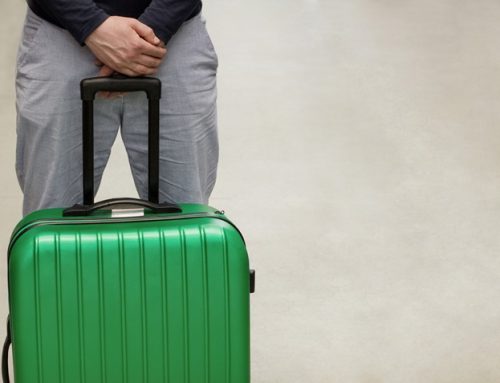How A Child Moves Through A Broken Immigration System
AS AN IMMIGRATION attorney working along the US-Mexico border in McAllen, Texas, Carlos García says he’s seen “a lot of sad stuff” over the years. But what he encountered at the McAllen federal courthouse Tuesday left him lost for words.
“You walk into the courtroom and there are 90 people waiting to be prosecuted for illegal entry,” he says. “When you talk to parents about losing their children and having their children taken away from them, it’s a different feeling. I can’t even describe it.”
García is one of several lawyers affiliated with the Texas Civil Rights Project who have offered legal assistance to detainees awaiting their fate at the local courthouse after the Trump administration began implementing its zero-tolerance policy in April. The policy refers to all illegal border crossings for a criminal prosecution, including asylum seekers and regardless of whether crossers are traveling with children. Since May, the government has separated 2,342 children from their families, according to the Department of Homeland Security, stoking widespread outrage as reports of the separations and photos of children sleeping in cages circulated on social media over the weekend.
President Trump signed an executive order Wednesday that would keep children with their parents in detention indefinitely. In a conference call with reporters, Gene Hamilton, counselor to the attorney general, said the order is effective immediately. But that still leaves thousands of families waiting to be reunited. Asked what happens to the kids currently being held, Hamilton said, “I’m going to have to defer to the Department of Homeland Security and the Department of Health and Human Services as to the specific answer to that question.” The Department of Health and Human Services did not respond to repeated requests for comment from WIRED.
Before the order was signed, the Texas Civil Rights Project’s lawyers interviewed more than 300 detainees over the last two weeks, none of whom have been confirmed to be reunited with their children.
“A couple of parents asked me, ‘How do I know I’m not going to be deported and my child won’t stay in the US?’” García says. “I didn’t have an answer for them.”
That’s because there are no easy answers. The system that tracks children from their initial capture at the border to their detention at group shelters and finally to their release to sponsors is as labyrinthine as it is opaque. (It took WIRED more than 20 rounds of emails to get answers from the three government agencies involved about how the process works.)
“The families I work with can’t find their kids. Across the board their experience is that they continue to ask their deportation officers where their children are and they are not told,” says Austin-based attorney Kate Lincoln-Goldfinch, whose firm works with hundreds of asylum seekers at a time.
The Women’s Refugee Commission is putting together recommendations for Congress and the White House to “establish a clear and consistent process by which DOJ, DHS, and HHS” record and track families who are separated, according to senior policy adviser for migrant rights Emily Butera. Among WRC’s recommendations are specifics like including the place separation occurred in every child’s case file, and providing parents with written and verbal information about where their children are being sent, as well as contact information for that facility, and the process for locating their child in detention. WRC also calls for regular phone calls between family members, a ban on time limits for those phones, and the promise that parents will be notified of and allowed to participate in any immigration court proceeding affecting their child, free of charge.
“This administration has separated children from their parents with no clear process for putting that family back together,” says Butera.
According to former government officials familiar with the current protocol, the system for handling children being separated from their parents is based on a process, designed around 2014, for unaccompanied minors crossing into the United States on their own. Often, these were teenagers with phone numbers memorized, US sponsors in mind, and parents back home awaiting their calls. Now, however, that same system is handling infants and toddlers, children who never planned on being on their own and whose parents are being moved between detention centers with limited access to phones. The already tenuous communication channels available to both parents and children in detention have been rendered relatively useless.
“I’m horrified,” says one former official at the Department of Health and Human Services who worked on the program that handled the influx of unaccompanied minors into the US during the Obama administration and spoke anonymously because of restrictions instituted by a current employer. “The long-term challenges of separating these kids and putting tender age children into a system that was designed to care for teenagers put a significant burden on the system and will create terrible long-term impacts.”
Piecing together how exactly a child moves through the system isn’t easy, but according to responses from the Customs and Border Patrol, Immigration and Customs Enforcement, legal experts, and former HHS officials, it goes something like this: When a child is detained at the border, CBP is responsible for collecting their information in a database called the Unaccompanied Children Portal. Both DHS and HHS have access to this portal. It’s where border agents enter details, including the child’s name, age, gender, country of origin, date of birth, and, if the child is a girl, whether she is visibly pregnant.
When children are separated from their parents at the border, they’re considered unaccompanied children and are entered into that database. Border Patrol assigns each person—child or parent—their own unique alien number used to identify and track them through government databases. The UC Portal does contain a field where border agents can write that a child has been separated from a parent and include the parent’s alien number. But this note is often the only record linking the parent and child. It’s unclear if such a note is appended to the parent’s file. Neither CBP nor HHS responded to WIRED’s request for comment on how they link records between parents and children.
Once border agents upload the child’s information to the portal, that record gets sent to HHS, which scans its shelters to find an available bed. The Office of Refugee Resettlement currently operates 100 shelters in 17 states. The child’s bed assignment passes back through the portal to Border Patrol, which is responsible for transferring the child to a facility. That facility may be thousands of miles from where he or she was apprehended.
Once the child reaches the facility, he or she is assigned a case manager, who begins the process of locating relatives who can take the child into their custody. In some cases, if the relative doesn’t have proper documentation, including the child’s birth certificate, the agency uses DNA testing to confirm they’re related. When a relative can’t be found, children are kept longer at government shelters or transferred to a sponsor’s care.
All the while, parents are being processed by a different agency, Immigration, and Customs Enforcement. Before their court dates, they’re given little more than a form with a number on it for the so-called Detention Reporting and Information Line, or DRIL line, which they can call for help locating their children. According to Zenen Jaimes, communications director at the Texas Civil Rights Project, that phone number wasn’t working when parents began calling in late May. Now it’s operational, but still far from perfect. Because few parents have access to their children’s alien numbers, they have to use details like name and date of birth to locate them.
“It’s very problematic because if the border patrol officer puts one letter in their name wrong, or their birthday wrong, you can’t find them,” says Lincoln-Goldfinch.
Immigrants in ICE detention are supposed to have access to free phone calls to contact lawyers, consulate workers from their home countries, and government hotlines where they can try to locate their children. The phones work differently in every facility. People need to input a special code to get access to those free calls. Advocates say that in some instances parents can’t figure out how to use the free line on the phones at all. Many parents do not speak Spanish, but rather speak indigenous languages that instructional pamphlets are not translated into. Advocates say long hold times have made it difficult for detainees to get through.
Lincoln-Goldfinch could point to only one instance where a client of hers was able to call their child. “And that was because a deportation officer took it upon herself to the schedule [a call]. It took a deportation officer who was willing to make the extra effort,” she says. In that particular case, the client was only able to locate her child because friends and family on the outside had tracked the child down.
Share this story!
Contact a U.S. Immigration Attorney Today!
Categories
How To Find Us
What Our Clients Say
“This Lawfirm is great, very professional and helpful. I love that they are always in communication and always available for when you have questions . 100% recommended by me and my family. Thank you Lincoln-Goldfinch Law – Abogados de Inmigración”





